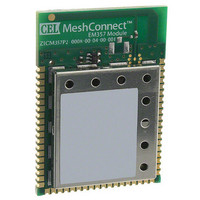ZICM357P2-1-B CEL, ZICM357P2-1-B Datasheet - Page 11

ZICM357P2-1-B
Manufacturer Part Number
ZICM357P2-1-B
Description
MOD EM357 ZIG 802.15.4 PCB ANT
Manufacturer
CEL
Datasheet
1.ZICM357P2-KIT1-1.pdf
(17 pages)
Specifications of ZICM357P2-1-B
Frequency
2.405GHz ~ 2.475GHz
Data Rate - Maximum
250kbps
Modulation Or Protocol
802.15.4 Zigbee
Applications
Home/Building Automation, Security, ZigBee™
Power - Output
20dBm
Sensitivity
-100dBm
Voltage - Supply
2.7 V ~ 3.6 V
Current - Receiving
28mA
Current - Transmitting
170mA
Data Interface
PCB, Surface Mount
Memory Size
192kB Flash, 12kB RAM
Antenna Connector
On-Board, Trace
Operating Temperature
-40°C ~ 85°C
Package / Case
*
Wireless Frequency
2483.5 MHz
Interface Type
SPI, TWI, UART
Security
AES
Operating Voltage
3.6 V
Output Power
20 dBm
Antenna
PCB Trace
Operating Temperature Range
- 40 C to + 85 C
Lead Free Status / RoHS Status
Lead free / RoHS Compliant
For Use With/related Products
EM357
Other names
ZICM357P2-1
ZICM357P2-1
ZICM357P2-1
PROCESSING
Recommended Reflow Profile
Pb-Free Solder Paste
Use of “No Clean” soldering paste is strongly recommended, as it does not require cleaning after the soldering process.
Note:
fication. See the latest IPC-A-610 Acceptability of Electronic Assemblies, Castellated Terminations section.
Cleaning
In general, cleaning the populated modules is strongly discouraged. Residuals under the module cannot be easily removed
with any cleaning process.
The best approach is to consider using a “no clean” solder paste and eliminate the post-soldering cleaning step.
Optical Inspection
After soldering the Module to the host board, consider optical inspection to check the following:
Repeating Reflow Soldering
Only a single reflow soldering process is encouraged for host boards.
Wave Soldering
If a wave soldering process is required on the host boards due to the presence of leaded components, only a single wave
soldering process is encouraged.
Parameters Values
Ramp up rate (from Tsoakmax to Tpeak)
Minimum Soak Temperature
Maximum Soak Temperature
Soak Time
TLiquidus
Time above TL
Tpeak
Time within 5º of Tpeak
Time from 25º to Tpeak
Ramp down rate
• Cleaning with water can lead to capillary effects where water is absorbed into the gap between the host board and
• Cleaning with alcohol or a similar organic solvent will likely flood soldering flux residuals into the two housings, which
• Ultrasonic cleaning could damage the module permanently.
• Proper alignment and centering of the module over the pads.
• Proper solder joints on all pads.
• Excessive solder or contacts to neighboring pads, or vias.
The quality of solder joints on the castellations (‘half vias’) where they contact the host board should meet the appropriate IPC
the module. The combination of soldering flux residuals and encapsulated water could lead to short circuits between
neighboring pads. Water could also damage any stickers or labels.
is not accessible for post-washing inspection. The solvent could also damage any stickers or labels.
3º/sec max
150ºC
200ºC
60-120 sec
217ºC
60-150 sec
250ºC
20-30 sec
8 min max
6ºC/sec max
MeshConnect™ EM357 Module
Page 11
Speci-










